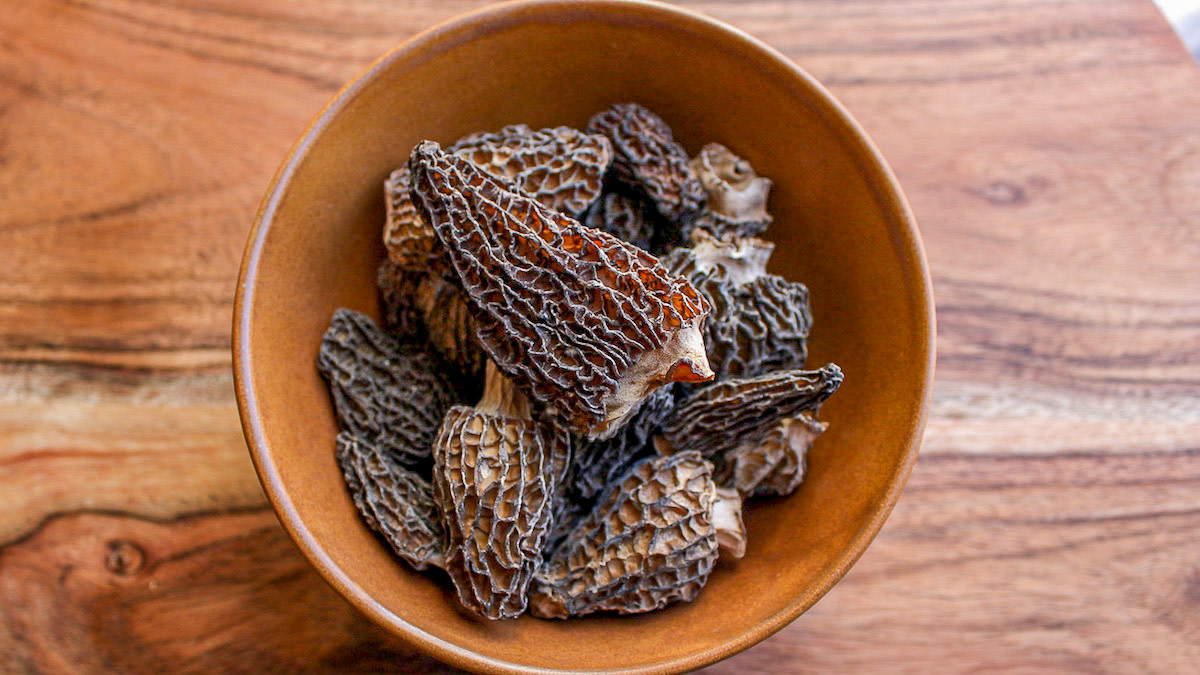
Nothing makes me more excited for spring than the prospect of picking a pile of morels. Once things start to green up, my thoughts become more and more occupied by the promise of the earthy aromatic. If you’re fortunate enough to have a big harvest this season, take what you don’t immediately eat or gift away and dry the rest.
Drying is a great way to preserve the integrity and flavor of the freshly foraged for year-round opportunities to up your umami game. Morels are awesome dried, but don’t stop there—try drying chanterelles, boletes, and other edible mushrooms available this spring.
Fresh is undoubtedly best, but when you’re eating morels in the middle of winter, it’s difficult to find anything worth complaining about. A lengthy hot water soak, albeit effective, isn’t the only option for reconstitution. Here are five methods to make the most out of your dried fungi.
Fried
This works best with whole or large pieces. Start by soaking dried morels in milk for about 20 minutes or until pliable. While your mushrooms are soaking, heat up a cast iron skillet on medium-high with a glug of oil to coat the pan. I like avocado or safflower oil but anything with a high smoke point will do.
Remove mushrooms from milk and dredge in all-purpose flour—just enough to lightly coat them—then place directly in hot oil. It should spit and hiss a little (if it doesn’t then heat the oil longer). Be sure to not crowd your pan; only fry one layer at a time.
Cook for a couple minutes on one side until the mushrooms are brown and crispy, then flip. Season with salt and pepper and add a couple pats of butter to the pan. Turn down the heat and make sure every mushroom gets equally basted, using a spoon to distribute butter as needed.
Eat them right out of the pan or serve on a perfectly cooked steak. Regardless of how you decide to consume, dried morels can taste pretty darn close to fresh ones after frying.
Simmered
If you are cooking something like venison stew, soup, or Bolognese or anything that requires simmering for a while, don’t worry about a pre-cook soak. They will rehydrate in the cooking liquid. While whole mushrooms provide awesome texture and visual appeal, this can also be a great use for the bottom-of-the-jar pieces.
Once you reach the point in your recipe where it’s time to simmer, throw in the morels, give it a stir, put on a lid, and be sure to give at least 10 minutes for the mushrooms to plump up. Allowing them to rehydrate in the sauce will make for a super flavorful dish.
Caramelized with Onions
This simple but flavor-packed accoutrement is extremely versatile and works best with small pieces or chopped up whole mushrooms. Slice a couple of yellow onions and begin the caramelization process in a pan on low heat with a pat of butter, pinch of salt, and a few red chili flakes. Stir occasionally to prevent burning.
Add mushroom pieces when the onions begin to turn translucent. Once onions are browning and sticking to bottom and sides of pan, about 20 minutes later, deglaze with wine, water, or stock, and cook until au sec. At this point, the onions and mushrooms should be completely caramelized and have a slightly sweet but ultimately savory profile.
It is important to consider that varying mushroom and deglazing liquid combinations will yield different results. Stock will add meatier notes, wine or sherry contribute some punch, and water will simply allow the caramelized flavors to shine.
Morels deglazed with red wine can make an out-of-this-world burger topping. Naturally sweet chantarelles pair nicely with a white wine deglaze, which goes great with smoked gouda to make a fancy grilled cheese.
Boiled In Pho or Ramen Broth
Before adding noodles to pho or ramen broth, allow about 5 minutes for a handful of mushrooms to rehydrate in the lightly boiling liquid. They will need to cook longer with added noodles.
If you harvested big mushrooms like boletes (also called porcinis), which tend to become dusty and crumbled in the bottom of the jar, they work great for pho or ramen. Whole mushrooms aren’t totally necessary because this technique is more about flavoring the broth with rich umami notes. If you do opt for whole or larger pieces, just be sure to accommodate with more cooking time.
After the mushrooms have had a few minutes to simmer, drop in your noodles. Add remaining ingredients like Thai basil, bean sprouts, cilantro, shredded shank, or thin-sliced raw backstrap to cook in the steaming broth.
Top a Pizza
This requires soaking the mushrooms. Try out this method: Give your French press a good clean, then put in the morels with some hot water just like you would make a pot of coffee.
After a 15- to 20-minute soak (or until pliable), press down, but try to not completely squish the mushrooms. Pour out the liquid but save it. It can be frozen in ice cube trays for later use in place of water while cooking grains, soups, or deglazing liquid for a pan sauce.
If you’re working with whole morels, slice lengthwise and put on a pizza with your favorite toppings or as an addition to this squirrel bacon pizza recipe. I like olive oil and garlic as a base topped with duck prosciutto, mozzarella, and fresh basil, finished with a drizzle of syrupy balsamic vinegar right when it comes out of the oven. Each bite will taste like spring, no matter what season it actually is.






Conversation